Water Not Coming Out of Your Shower Head?
Author: Omar Alonso | Editor: Omar Alonso
Review & Research: Jen Worst & Chris Miller
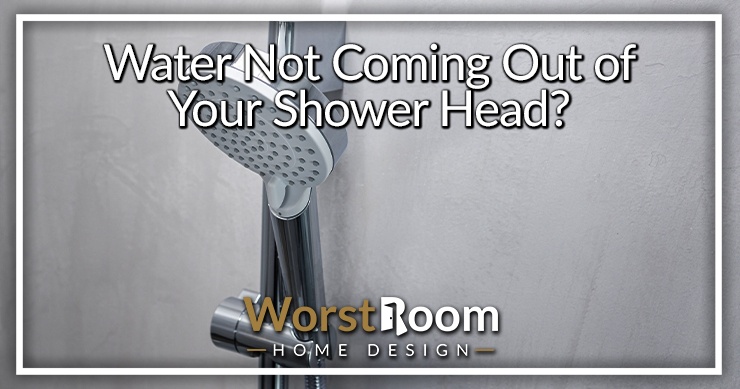
You step into the shower to start your morning routine, and the showerhead doesn't want to play ball. It stutters and stops delivering water, with a weak stream coming from the head. Great. Your morning is ruined before it even starts. Why is water not coming out of your shower head properly?
What can you do to resolve the problem? Fortunately, you can return the showerhead to normal operation with a few easy hacks.
Why Is Water Not Coming Out of the Shower Head?
If the water isn't coming out of the showerhead properly or doesn't come out at all, there's usually a blockage in the plumbing system or the showerhead itself.
The Four Main Reasons a Shower Head Fails to Release Water
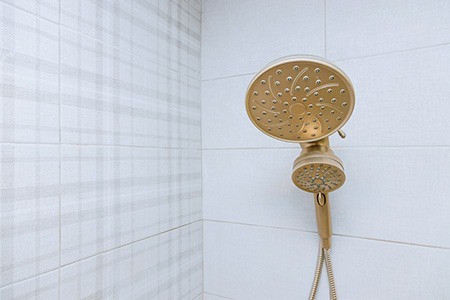
While these certainly aren't the only reasons, you will very likely find out why shower water is not coming out of your shower head here. Most likely the showerhead is clogged or has mineral deposits. I recommend starting your investigation there once you're done reading.
Clogged Shower Head
A clogged showerhead is usually the issue if the pressure is lower than normal or there's an interruption in the normal water delivery through the head. Mineral deposits, soap scum, and debris in the pipework are the usual suspects for this issue. This can affect all types of shower heads.
Clogged Pipework
If no water arrives at the showerhead, the most common cause is a blockage in the pipes leading to the shower.
Mineral Deposits
If you have hard water in your area, it contains more minerals than soft water. As a result, the showerhead jets may accumulate calcium and magnesium deposits, blocking the water flow to the head.
Corroded Pipes
If you notice the water comes out of the showerhead with a brown color, it's a sign of corrosion in the pipework. The only way this is really the cause for water not coming out of your shower head is if the corrosion was so severe that there was a sudden break and water is leaking out inside the interior of your home. You'd have noticed this by now.
Corrosion would otherwise involve a slow build up where you'd have noticed less and less water flow over time. If that's the case, you have a good indication that it's corrosion or mineral deposits in the pipes, or a gradual clog.
Remove & Clean the Pipework
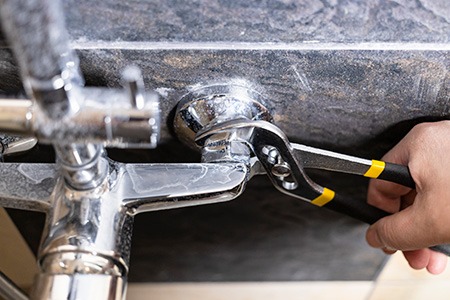
If you have a problem with the plumbing delivering water to your showerhead, you must remove and clean the pipes. Deep cleaning of the lines is important to remove blockages and return the system to working order.
However, it's a challenging task. If your shower pipes are built into the wall, you'll have to break the wall to get at the pipes. In most cases, you'll need the assistance of a professional plumber for the task. The plumber uses a specialized cable tool, rodding kit, or cable tool to access the pipes and clean them out before they break through the wall.
The process requires the plumber to use a specialized tool and cleaning solvent to clean the pipework. Removing the particles or blockages in the pipes is essential to prevent pressure building in the system that cracks the lines.
Unfortunately, the process only works if you have access to both sides of the pipes and the wall. In some cases, if the blockage is severe, the plumber will have to repeat the process several times. If your shower head has been too low and not at the standard shower head height, this is a chance to have them fix that.
Use Air Pressure to Remove the Clog
If you have issues with clogged pipes, the plumber might decide to flush them out using air-pressure tools. They insert an air hose into one end of the drain and direct it toward blockages in the line. They'll connect a device to the other end of the hose and switch it on to push air through the system and free the pipes from the clog.
Replace the Pipework
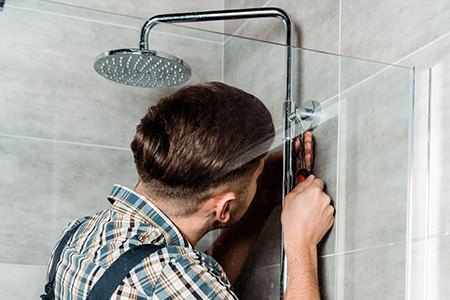
In some cases, such as corroded pipes, you'll need to replace them. Once again, this job is for professionals, and you'll need assistance from a plumber to do it right. It's important to have a plumber inspect the pipes in your home every other year to ensure they don't have blockages or show signs of corrosion.
Water Heater Sediment Buildup
Another common cause of a blocked showerhead reducing flow is sediment buildup in the water heater. If sediment builds up in the system, it prevents the showerhead from receiving enough water to reach optimal working efficiency and performance.
In most cases, when sediment builds up in the system, the water heater becomes dysfunctional and can't reach operating temperature. As a result, you'll notice a dip in flow and water pressure throughout your entire plumbing system and all the faucets in your home.
You'll need to flush the water heater and remove the sediment or replace it if you have a heater in service for 10 or 15 years. Water not coming out of your shower head can happen suddenly in this case when some sediment gets dislodged and sucked into the pipe. While you're tinkering with the water heater, go ahead and adjust the water temperature if needed.
The Shower Head is Clogged or Worn
The issue with shower heads is that they don't last forever. The problem could be as simple as a worn showerhead needing replacement. We recommend choosing a high-quality stainless steel or chrome showerhead offering easy installation and good looks to complement your bathroom décor.
A Step-by-Step Guide to Fix the Shower Diverter Valve
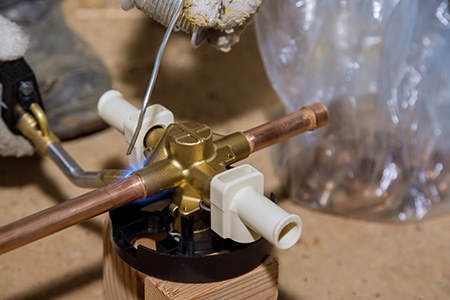
Most showers have a separate handle for turning on the hot and cold water. These handles control a valve at the base of the pipework feeding water to the shower. The diverter valve might be damaged and fail to open, causing no water delivery to the showerhead.
As a result of a blocked or dysfunctional diverter valve, you might notice water coming out of the tub instead. You'll need to call a plumber to come out and fix or replace the diverter valve to get the shower working again.
1) Turn Off the Water
The first step is to turn off the water going to the shower. Since most showers don't have a separate valve readily available to turn off the water, you'll probably have to turn off the water at the mains.
However, if you're dealing with a part of the system in front of the faucets, all you need to do is turn them off, and that's fine. Open the taps and let the water drain through the pipes before moving on to the next step.
2) Seal the Drain
Access the drain by removing the drain cover in the tub. Seal off the drain using painter's tape to prevent anything materials, like screws, from falling into the drain where you can't retrieve them. Plumbers usually have a plastic plug they insert into the drain to prevent anything from falling into it while they work.
3) Tighten the Screws Holding the Diverter Valve
Use a screwdriver to tighten the screws behind the diverter valve faceplate. Don't overtighten the screws, as you might strip the threads. You want them firmly in place but not too tight. If this hack doesn't solve the problem, you must replace the diverter valve.
4) Replace the Diverter
If the diverter valve is faulty, you have no option but to replace it. The diverter valve can appear behind the faucet or the showerhead. A plumber should have the experience to know where it is in your specific installation. They'll locate the valve and remove it, replacing it with a new part. The plumber also cleans the space, removing any debris they find.
Shower Head is Dripping or Leaking
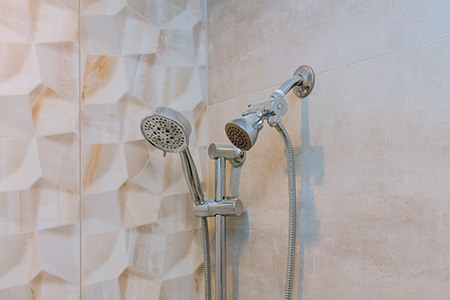
Let's say water not coming out of your shower head isn't your exact problem. If the shower head is dripping or has a low flow rate, you can look at the following issues to see if they're causing the problem. In most cases, it's to do with sediment buildup in the showerhead due to hard water depositing minerals in the jets, but that's not always the case.
Clogged Pipework
There might be debris in the shower pipes affecting the optimal delivery of water through the shower system. Or there might be loose parts causing blockages in the lines.
Clogged Showerhead
As mentioned, the most common reason for a dysfunctional showerhead is the accumulation of minerals in the jets, causing blockages. As a result, you'll get fewer jets working and lowered performance from the showerhead.
Remove the showerhead from the arm and place it in a bucket. Submerge the showerhead in white spirit vinegar and leave it there for four to five hours. Remove the showerhead, and scrub the jets with an old toothbrush or similar cleaning tool.
Fit it to the shower arm and turn on the shower. You should notice the performance improve. While you're doing this, you may consider removing the shower head flow restrictor.
Closed Shower Valve
The calcium in hard water may accumulate in the shower valve, creating a blockage. As a result, you'll need to replace the valve. We recommend hiring a plumber for the task. This internal component is separate from the diverter valve.
FAQs For When There’s No Water From the Shower Head
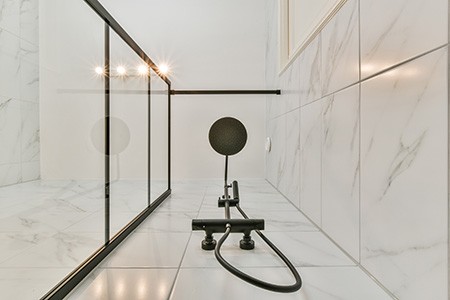
When shower water is not coming out as expected, there’s always more details needed than anyone provides. Let’s clear up some extra questions so you’re not left in the dry and the dark.
Do I Need to Turn Off the Water Main to Work On or Replace a Shower Head?
In some instances, depending on where you're working on the shower pipes, you might only have to turn off the shower faucet controlling the water delivery to the showerhead. If you're cleaning or replacing the showerhead, turn off the tap. However, if you're replacing valves, turn off the water main.
How Often Should I Replace My Shower Head?
Most homeowners don't realize they should replace their showerhead every six to 12 months, depending on the water conditions in their area. The minerals accumulated in the showerhead block the jets if you have hard water sources. As a result, you'll need to clean the showerhead every few weeks and replace it every six to 12 months.
Can I Fit Any Size Shower Head in the Shower?
Yes, showerheads are universal in your region anyways. All showerheads in the United States use a standard ½" NPT threading size.
Key Takeaways for a Waterless Shower Head
- If the shower has no water coming out of it, it's likely a problem with the pipes.
- If the showerhead is trickling or lowers performance, it's probably an issue with the showerhead.
- Common problems with pipework include blockages, worn valves, or the water heater.
- If you live in an area with hard water, minerals will accumulate in the pipes and valves and cause blockages or disruptions to the water heater.
- You'll most likely need a plumber to help you with the problem.
- Showerhead jets accumulate mineral deposits and require cleaning every few weeks and replacement every six to 12 months.
That’s Why Water Isn’t Coming Out of Your Shower Head
Why is water not coming out of your shower head? It’s typically a clogged shower head, but you also could be dealing with clogged pipes, corroded pipes, or mineral deposits. The easiest thing to do is to try to clear the shower head, freeing it from clogs and mineral deposits. If it will allow water through, but doesn’t when it’s attached to your shower pipe, then you need to begin investigating deeper issues, because your shower is failing to allow water to flow through.



